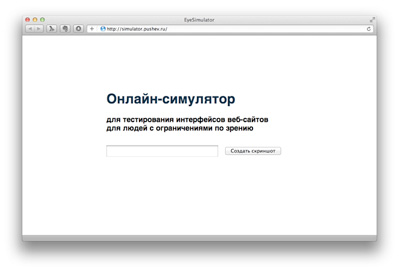Online simulator for testing and testing interfaces for people with disabilities
One of the problems that everyone can face is aging, and the associated possibilities of vision, the ability to distinguish the smallest details, to see at dusk, etc. At the same time, you need to understand that each next generation comes to old age more and more “computerized”, accustomed to carry out many actions using a personal computer, tablets, smartphones and other devices with different input interfaces.
Therefore, nowadays, when developing interfaces for devices and information systems, developers simply cannot ignore such a segment of the audience - as people with disabilities. From the point of view of development, specialized committees of various countries and communities have done a lot to define the rules and standards of development that take into account the limited capabilities of people, however, developers sometimes lack simple applications for visual testing of the created interfaces.

')
Link to the project: http://bit.ly/eyesim
As a solution to one of these problems, I created and developed a project for an online service of testing a web-interface simulator according to various criteria of people with disabilities.
The main functionality of the service is the ability of any Internet users to specify the address of an Internet resource in the input field, automatically receive a screenshot of the specified site page and start applying filters to the received picture, each of which corresponds to a particular limitation in vision. the extent of a given visual impairment, for example, for the loss of a central field of view (the area of the field unavailable for viewing is regulated). Also, the simulator implements the user's eye tracking functionality: the selected filter is tied to the cursor, thus moving the pointer through the interface the simulator user can move the resulting defect field through the picture, which effectively detects areas completely inaccessible to users with limited vision. Data on the type of visible defects for various filters simulators were taken from the Cambridge Design Center, other simulator application programs for Windows operating systems, technical devices and filters for emulating the vision of people with disabilities.
Who can be useful for such a project:
1. To professional developers of information systems interfaces, testers and other specialists, one way or another involved in the development of interfaces;
2. For non-commercial audience - each person, the owner of the site, service will be able to check the availability of their resources for people with disabilities;
3. For friends, family members of people with disabilities - it is possible to use such a simulator will help such people to better understand the features of their loved ones, which will provide them with more correct support.
2012, Lyubich M.V.
Therefore, nowadays, when developing interfaces for devices and information systems, developers simply cannot ignore such a segment of the audience - as people with disabilities. From the point of view of development, specialized committees of various countries and communities have done a lot to define the rules and standards of development that take into account the limited capabilities of people, however, developers sometimes lack simple applications for visual testing of the created interfaces.

')
Link to the project: http://bit.ly/eyesim
As a solution to one of these problems, I created and developed a project for an online service of testing a web-interface simulator according to various criteria of people with disabilities.
The main functionality of the service is the ability of any Internet users to specify the address of an Internet resource in the input field, automatically receive a screenshot of the specified site page and start applying filters to the received picture, each of which corresponds to a particular limitation in vision. the extent of a given visual impairment, for example, for the loss of a central field of view (the area of the field unavailable for viewing is regulated). Also, the simulator implements the user's eye tracking functionality: the selected filter is tied to the cursor, thus moving the pointer through the interface the simulator user can move the resulting defect field through the picture, which effectively detects areas completely inaccessible to users with limited vision. Data on the type of visible defects for various filters simulators were taken from the Cambridge Design Center, other simulator application programs for Windows operating systems, technical devices and filters for emulating the vision of people with disabilities.
Who can be useful for such a project:
1. To professional developers of information systems interfaces, testers and other specialists, one way or another involved in the development of interfaces;
2. For non-commercial audience - each person, the owner of the site, service will be able to check the availability of their resources for people with disabilities;
3. For friends, family members of people with disabilities - it is possible to use such a simulator will help such people to better understand the features of their loved ones, which will provide them with more correct support.
2012, Lyubich M.V.
Source: https://habr.com/ru/post/140030/
All Articles